Temple Newsam
Temple Newsam (historically Temple Newsham), (grid reference SE357322) is a Tudor-Jacobean house in Leeds, West Yorkshire, England, with grounds landscaped by Capability Brown.
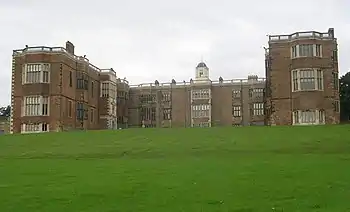
The estate lends its name to the Temple Newsam ward of Leeds City Council, in which it is situated, and lies to the east of the city, just south of Halton Moor, Halton, Whitkirk and Colton. It is one of nine sites in the Leeds Museums & Galleries group.
The house is a Grade I listed building, defined as a "building of outstanding or national architectural or historic interest". The stables are Grade II* listed ("particularly significant buildings of more than local interest"), and ten separate features of the estate are Grade II listed ("buildings of special architectural or historic interest"), including the Sphinx Gates and the Barn.[1] Temple Newsam House is one of Leeds Museums and Galleries sites.[2] It is also part of the research group, Yorkshire Country House Partnership.[3]
History
In the Domesday Book of 1086 the manor is listed as Neuhusam (meaning new houses) and was held by Ilbert de Lacy and his sons.[4] Before the Norman Conquest of 1066 it had been held by Dunstan and Glunier, Anglo-Saxon thanes.[4] In about 1155, Henry de Lacy gave it to the Knights Templar, who built Temple Newsam Preceptory on a site near the present house.[5] The Templars farmed the estate very efficiently, with 1100 animals.[6] In 1307 the Templars were suppressed, and Edward II granted the manor to Sir Robert Holland who held it until 1323 when he was deprived of his estates.[6] The Templars tried to retake the estate but they were forced to surrender and in 1327 it was granted to Mary de St Pol, the Countess of Pembroke, who held the manor for 50 years.[6] In 1377 by royal decree the estate reverted to Philip Darcy, 4th Baron Darcy de Knayth (1341–1398).[6] It then passed through several members of the Darcy family, until it was inherited by the 21-year old Thomas, Lord Darcy in 1488.[7] Between 1500 and 1520 a Tudor manor house, known as Temple Newsam House, was built on the site.[8] It has also been spelled "Newsham" in the past.[9]
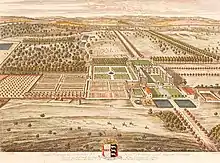
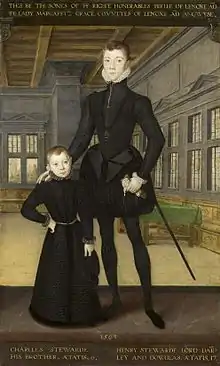
In 1537 Thomas, Lord Darcy was executed for the part he played in the Pilgrimage of Grace and the property was seized by the Crown.[7] In 1544 Henry VIII gave it to his niece Lady Margaret Douglas (Countess of Lennox), and she lived there with her husband Matthew Stewart, 4th Earl of Lennox.[7] Their son Henry Stuart, Lord Darnley, who was born in the house in 1545 and educated there, married Mary, Queen of Scots, by whom he was the father of King James VI of Scotland and I of England.[10] A portrait of Henry and his brother was probably intended to represent the interior of Temple Newsam despite being based on a print of an ideal interior.[11] Following the marriage in 1565, Temple Newsam was seized by Queen Elizabeth I and was managed by an agent.[12] In 1603 King James I, successor to Elizabeth, granted it to his Franco-Scottish second cousin Ludovic Stewart, 2nd Duke of Lennox (1574-1624), who in 1606 was also granted Cobham Hall in Kent, but subject to the interest of the life tenant. In 1622 the estate was bought by Sir Arthur Ingram for £12,000. During the next 20 years the mansion was rebuilt, incorporating some of the previous house in the west wing.[8]
Sir Arthur's grandson Henry Ingram, 1st Viscount of Irvine (created Viscount of Irvine in 1661 (also spelt "Irwin"[2]) married Lady Essex Montagu, a daughter of Edward Montagu, 2nd Earl of Manchester. Between 1736 and 1746 Henry Ingram, 7th Viscount of Irvine remodelled the west and north wings of the house, creating new bedrooms and dressing rooms and the picture gallery.
In the 1760s Charles Ingram, 9th Viscount of Irvine, employed Capability Brown to re-landscape the park. The work was continued by his widow Frances Shepheard, who rebuilt the south wing, and lived at Temple Newsam until her death in 1807. Their eldest daughter Isabella Ingram, (Marchioness of Hertford) (d.1834) was, for a time, the mistress of the Prince of Wales (later King George IV), who in 1806 visited Temple Newsam and presented her with Chinese wallpaper, hung in the small Drawing Room next to the Great Hall, and the Moses Tapestries. Lady Hertford inherited the house in 1807 and bequeathed it to her younger sister Frances Ingram, wife of Lord William Gordon.
In 1820 the novelist Sir Walter Scott published Ivanhoe featuring a Templar preceptory named Temple Stowe, believed to have been modelled on Temple Newsam; the name is preserved in local road names such as Templestowe Crescent.[13]
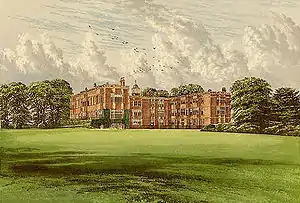
In 1841 the estate was inherited by Hugo Meynell-Ingram (d.1871), son of Elizabeth Ingram, sister of Frances Ingram (Lady Gordon). Following his death in 1871 his wife Emily Meynell Ingram (d.1904) inherited the estate and developed it considerably. She bequeathed it to her nephew Edward Wood, 1st Earl of Halifax.[8]
In 1909, 610 acres (2.5 km2) of the estate at Knostrop were compulsorily purchased by Leeds Corporation to build a sewage plant.[14] During the First World War (1914–17) the south wing of the house was turned into a hospital by Edward Wood and his wife Dorothy. Edward Wood fought in France as part of the Yorkshire Hussars, whilst Dorothy oversaw the running of the hospital as part of the Mayors War Committee[15] In 1922 Edward Wood sold the park and house to Leeds Corporation for a nominal sum, placing covenants over them to ensure their preservation for the future.[14]
On 19 October 1923, Temple Newsam was opened to the public along with a golf course.[16] In the Derby Daily Telegraph newspaper, Temple Newsam was compared to Hampton Court.[16] Despite many people visiting the house and using the golf course, the Corporation lost money during the first decade mostly due to poor farming practices.[16] In July 1932, the Great Yorkshire Show was held at Temple Newsam and was a great success.[16] Preparations for war were made as early as April 1939, and in August, small items were being packed up for storage.[16] In September 1939, Temple Newsam was closed to the public and items were moved there for storage from Leeds City Art Gallery.[16] It was decided that objects would be displayed, and the house was officially reopened in November 1939, when it was again likened to Hampton Court in the press.[16]
Architecture

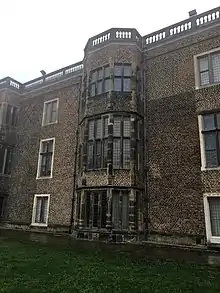
Remains of the early 16th century hours were retained in the new building, including the brickwork and bay windows in the centre of the west front.[17] The plan of the new house was a conservative E-shape.[17] The Long Gallery and entrance hall in the south wing followed Elizabethan and early Jacobean styles.[17] The entrance porch has Classical columns but they are of Flemish design, rather than following correct Italian design.[17] Round the top of the house, letters appear in a balustrade, declaring the piety and loyalty of Sir Arthur Ingham: 'ALL GLORY AND PRAISE BE GIVEN TO GOD THE FATHER THE SON AND HOLY GHOST ON HIGH PEACE ON EARTH GOOD WILL TOWARDS MEN HONOUR AND TRUE ALLEGIANCE TO OUR GRACIOUS KING LOVING AFFECTION AMONGST HIS SUBJECTS HEALTH AND PLENTY BE WITHIN THIS HOUSE.'[17] The chapel in the north wing retains some 17th century features, such as armorial stained glass, probably by Henry Gyles and a carved wooden pulpit by Thomas Ventris, made around 1636, with geometric patterns, pilasters and friezes.[17] The walls had panels of Old Testament figures, painted by John Carleton.[17]
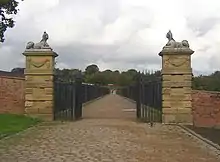
.jpg.webp)
The house was almost entirely remodelled in the 18th century.[17] Henry, 7th Lord Irwin, wanted to follow Palladian design and used craftsmen from York to do so.[18] The ceilings in the new Saloon and Library, made from the old Long Gallery, were decorated by Thomas Perritt and Joseph Rose.[18] The doorcases are elaborately carved, probably by Richard Fisher.[18] Two chimney pieces in the Saloon were based on designs by William Kent.[18] The distinctive sphinx gate piers by Lancelot Brown were based on designs published by Lord Burlington in 1738 and used at Chiswick.[18][1] The main rooms in the west wing were redecorated and the windows were replaced with sliding sash windows.[18] A large pedimented stable block was built to the north of the house.[18]
In 1796, Frances Shepheard employed a Mr Johnson to alter and reface the south wing in a style which tried to copy that of Sir Arthur Ingram's original house.[18] Her approach was a departure from the designs for the wing commissioned by her dead husband from John Carr and Robert Adam, as well as the landscaping by Capability Brown who was also consulted about rebuilding the south wing.[18]
Coalmining on the estate
Estate records show the existence of coal pits in and around the park in the seventeenth century and Bell Wood to the south of the house would have had bell pits for coal extraction. A colliery at Halton village was leased to a number of different individuals from 1660 through to at least the 1790s. The leases generally required the leaseholder to supply coals to Temple Newsam house.[19]
In 1815, William Fenton, one of the 'Coal Kings' of Yorkshire,[20] began the sinking of a mine shaft on the estate at Thorpe Stapleton. The colliery was named Waterloo to commemorate the famous battle of that year.[21] Waterloo Colliery was operated as a royalty concession with contracted 'rents' for coal extracted going to the Temple Newsam landowner. Fenton also had a village built for his workers on land between the River Aire and the Aire and Calder navigation. The village was initially called Newmarket but then became Irwin Square on ordnance survey maps[22] and Ingram Place on census lists, but it was commonly simply known as Waterloo. The Yorkshire, Lancashire and England cricketer Albert Ward was born here in 1865. The village had two rows of cottages and a school building. It was connected to the colliery by a wooden footbridge over the river.[23] Deep coal mining on the estate ended with the closure of the Temple Pit of Waterloo Main Colliery in 1968.
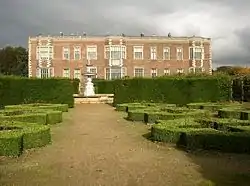
Opencast mining on the estate began in May 1942. Seven sites were exploited to the south of the house almost entirely destroying Capability Brown's landscape. One site reached within 330 feet (100 m) of the South Terrace. It continued at the Gamblethorpe site as far as Dawson's Wood, in full view of the house, until 1987.[24] No trace of the opencast remains now as the parkland was re-landscaped.
In 2019 there was a temporary exhibition about coal mining at Temple Newsam which was called 'Blot on the Landscape'.[25]
House and estate today
The house and estate are owned by Leeds City Council and open to the public. The house has undergone substantial restoration to its exterior. There is an established programme of restoring rooms back to known previous configurations, reversing the numerous intrusive installations and modifications that took place during the building's "art museum" phase.
The wider estate is made up of woods (the second largest part of the Forest of Leeds).[26] There are sporting facilities for football, golf, running, cycling, horse-riding and orienteering. There is an innovative children's playground opened in 2011 which caters for both disabled and able-bodied children.[27] Pegasus Wood, to the south of the house, commemorates veterans of the Normandy Landing at Pegasus Bridge in 1944.[28]
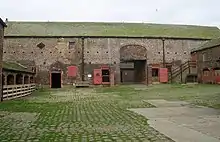
The Home Farm, open to the public, has a barn built in 1694 and is the largest working rare breeds farm in Europe, and only one of 16 nationally approved by the Rare Breeds Survival Trust. Breeds include Gloucester, Kerry, Irish Moiled, Red Poll, White Park, British White, Beef Shorthorn, Vaynol and Belted Galloway cattle; Kerry Hill; Whitefaced Woodland and Portland sheep, and Golden Guernsey goats.[29] The farm was targeted by arsonists twice in 2011 with damage caused to buildings, and some animals killed.[30]
There are extensive gardens, with a celebrated rhododendron walk and six national plant collections: Aster novi-belgii (Michaelmas daisies), Phlox paniculata, Delphinium elatum (Cultivars), Solenostemon scutellarioides (sys. Coleus blumei), Primula auricula and Chrysanthemum (Charm and Cascade cultivars).[31] Within the Walled Garden there are 800 yards of herbaceous borders.[32]
Collections
There are substantial holdings of fine and decorative art which are designated by the Department of Culture, Media and Sport (DCMS) as being of national significance.[33]
Of most significant historical and cultural interest is the Chippendale Society collection of Chippendale works that are on permanent loan.[34] In his book "Britain's Best Museums and Galleries", Mark Fisher (a former DCMS minister) gave the museum an excellent review. When interviewed on Front Row, Radio 4, November 2004 Fisher placed Temple Newsam House in the top three non-national museums in the country, along with Birmingham's Barber Institute and the Dulwich Picture Gallery.[35]
Events
Party in the Park and Opera in the Park were annual ticketed concerts organised by Leeds City Council and Radio Aire, which respectively have accommodated 70,000 and 50,000 spectators.[36] Both were held in July on the site from 1994 to 2014.[37] They took place on the grassed area which slopes down at the front of the house.
An amphitheatre near the stables block is used for occasional open-air theatre performances, and the fields to the north of the Home Farm are used for various events such as Steam Fairs and Dog Shows.
In August 1997 and 1998 the estate was the site of the V Festival but, after the success of the event, this was replaced by a new northern leg of the Reading and Leeds Festivals from 1999, taking place the weekend after the regular V festival slot in August. The Leeds Festival however moved to Bramham Park after the 2002 event when the festival was marred by riots and violence in the festival grounds, and trouble in the surrounding estates of east Leeds.[38]
Sven Vath hosted Cocoon in the Park every July with the organisers behind Mint Club and Mint Festival from 2009 - 2019.[39]
In 2019 it became the new home to Slam Dunk Festival as it had grown and moved out of the city centre of Leeds.[40]
Many other events take place at Temple Newsam, such as the Leeds Waggy Walk event for Dogs Trust[41] and Race for Life for Cancer Research UK.[42] Since early 2013, there has been a weekly Parkrun event.[43]
The organisers behind the Mint Warehouse, Mint Club and Mint Festival who have hosted Cocoon in the Park every July from 2009 - 2019 launched a new festival called Newsam Park to replace Cocoon in the Park.[39]
See also
References
- "Historic England". Retrieved 3 October 2020.
- "Temple Newsam". Leeds City Council Museums and Galleries. Retrieved 20 June 2019.
- "Yorkshire Country House Partnership". Retrieved 3 October 2020.
- Temple Newsam House. The Libraries & Arts Committee of the Leeds Corporation. 1951. p. 13.
- Wheater, William (1868). Temple Newsam: its history and antiquities. A. Mann, Leeds. pp. 7–8.
- Temple Newsam House. The Libraries & Arts Committee of the Leeds Corporation. 1951. p. 14.
- Temple Newsam House. The Libraries & Arts Committee of the Leeds Corporation. 1951. p. 15.
- Temple Newsam: House Guide. Leeds City Council.
- "Whitkirk: Geographical and Historical information from the year 1868". GENUKI. Retrieved 28 October 2007. Transcribed from The National Gazetteer of Great Britain and Ireland 1868
- Bingham, Caroline (1995). Darnley: A Life of Henry Stuart, Lord Darnley, Consort of Mary Queen of Scots. Constable. p. 38.
- "Catalogue 53: 3 HENRY STEWART, Lord Darnley, and his brother, CHARLES STEWART, Earl of Lennox" (PDF). Hans Eworth & the London Stranger Painters. Retrieved 25 October 2020.
- Temple Newsam House. The Libraries & Arts Committee of the Leeds Corporation. 1951. p. 17.
- "On the trail of the Templars". Leeds: Local history. BBC. Retrieved 21 June 2017.
- Temple Newsam: Country House Estate Trail. (2007) Leeds City Council.
- "Temple Newsam: A Country House Hospital • Life in WW1 Country House Hospitals • MyLearning". www.mylearning.org. Retrieved 31 January 2020.
- Ward, Steve (2017). Tales from the Big House: Temple Newsam: The Hampton Court of the North. Pen & Sword History. pp. A Peoples House. ISBN 9781473893375.
- Linstrum, Derek (1969). Historic Architecture of Leeds. Oriel Press. pp. 16–17.
- Linstrum, Derek (1969). Historic Architecture of Leeds. Oriel Press. p. 19.
- Gilleghan, John (2004). Halton: The Story of an East Leeds Village. The Kingsway Press. ISBN 1412029457.
- Goodchild, John (1978). The Coal Kings of Yorkshire. Wakefield Historical Society.
- Goodchild, John (1978). The Coal Kings of Yorkshire. Wakefield Historical Society. p. 55.
- "OS Six Inch England and Wales: Yorkshire 218 National Library of Scotland". Retrieved 8 March 2020.
- Goodchild, John (1978). The Coal Kings of Yorkshire. Wakefield Historical Society. pp. 70–71.
- Work and Play at Temple Newsam: Exhibition Guide Leeds City Council
- "Blot on the Landscape". Retrieved 3 October 2020.
- "Forest of Leeds: Temple Newsam Woodlands". Leeds City Council. Archived from the original on 16 November 2007. Retrieved 28 October 2007.
- "7 of the very best playgrounds to visit with the kids in Leeds". Leeds Live. Retrieved 3 October 2020.
- Parkrun Ltd., Temple Newsam parkrun: latest news, published 25 February 2014, accessed 29 January 2021
- "Temple Newsam Home Farm". Retrieved 3 October 2020.
- "Fire at Temple Newsam Home Farm kills 34 animals and birds". BBC News. 23 November 2011.
- "The National Council for the Conservation of Plants and Gardens". Retrieved 20 September 2007.
- Leeds City Council, Gardens at Temple Newsam, accessed 22 November 2020
- "Arts Council Designated Collections" (PDF). Retrieved 3 October 2020.
- "The Chippendale Society". Retrieved 3 October 2020.
- http://www.leeds.gov.uk/templenewsam
- "Party in the Park 2006". BBC - Leeds. 18 July 2006. Retrieved 11 May 2008.
- "Leeds Party in the Park". tilllate.com. 15 July 2007. Retrieved 11 May 2008.
- "Festival marred by violence". BBC News. 26 August 2002. Retrieved 28 October 2007.
- "History". Cocoon in the Park. Retrieved 23 October 2019.
- "Everything you need to know about Slam Dunk Festival Leeds 2019 - line-up, times and tickets". Yorkshire Evening Post.
- Waggywalks
- "Leeds (Temple Newsam)". Race for Life. Archived from the original on 26 June 2010. Retrieved 4 October 2010.
- "Temple Newsam Parkrun". Parkrun website. Parkrun. Retrieved 10 February 2013.
External links
| Wikimedia Commons has media related to Temple Newsam. |
- "Official website". Leeds City Council. Archived from the original on 30 June 2013.
- "At home with the Knights Templar". Leeds Local History. BBC Radio Leeds. 19 May 2006.
- Tour of Temple Newsam in 1920s photos from Leodis database
- Historic England. "The house (Grade I) (1255943)". National Heritage List for England.
- Historic England. "Stables (Grade II*) (1255954)". National Heritage List for England.
- Historic England. "Barn (Grade II) (1255911)". National Heritage List for England.
- Historic England. "Boundary wall (Grade II) (1255951)". National Heritage List for England.
- Historic England. "Bridge (Grade II) (1255912)". National Heritage List for England.
- Historic England. "Dovecote, laundry, sheds (Grade II) (1255948)". National Heritage List for England.
- Historic England. "Fountain (Grade II) (1255945)". National Heritage List for England.
- Historic England. "Home Farmhouse (Grade II) (1255947)". National Heritage List for England.
- Historic England. "Little Temple (Grade II) (1255949)". National Heritage List for England.
- Historic England. "North lodges (Grade II) (1255950)". National Heritage List for England.
- Historic England. "Sphinx Gates (Grade II) (1255952)". National Heritage List for England.